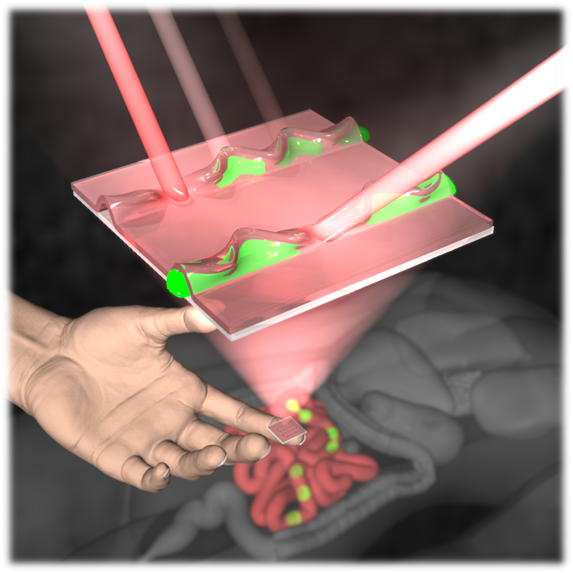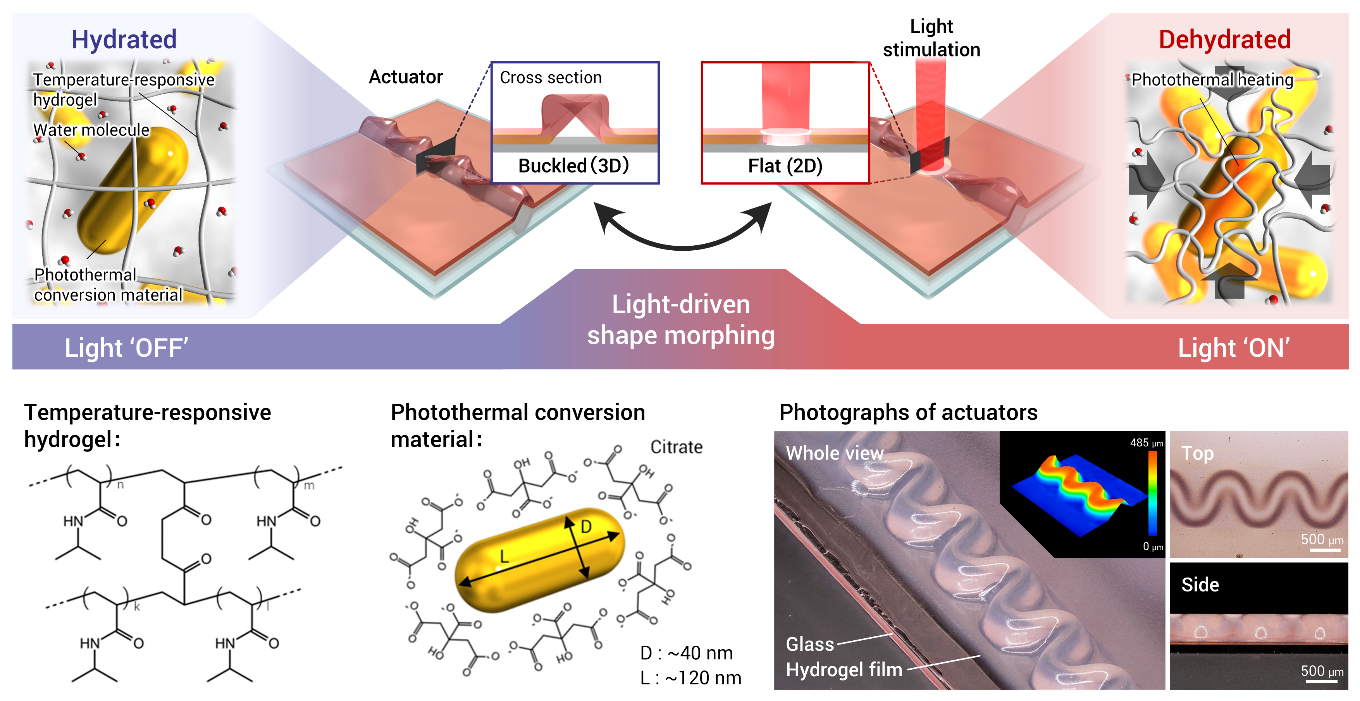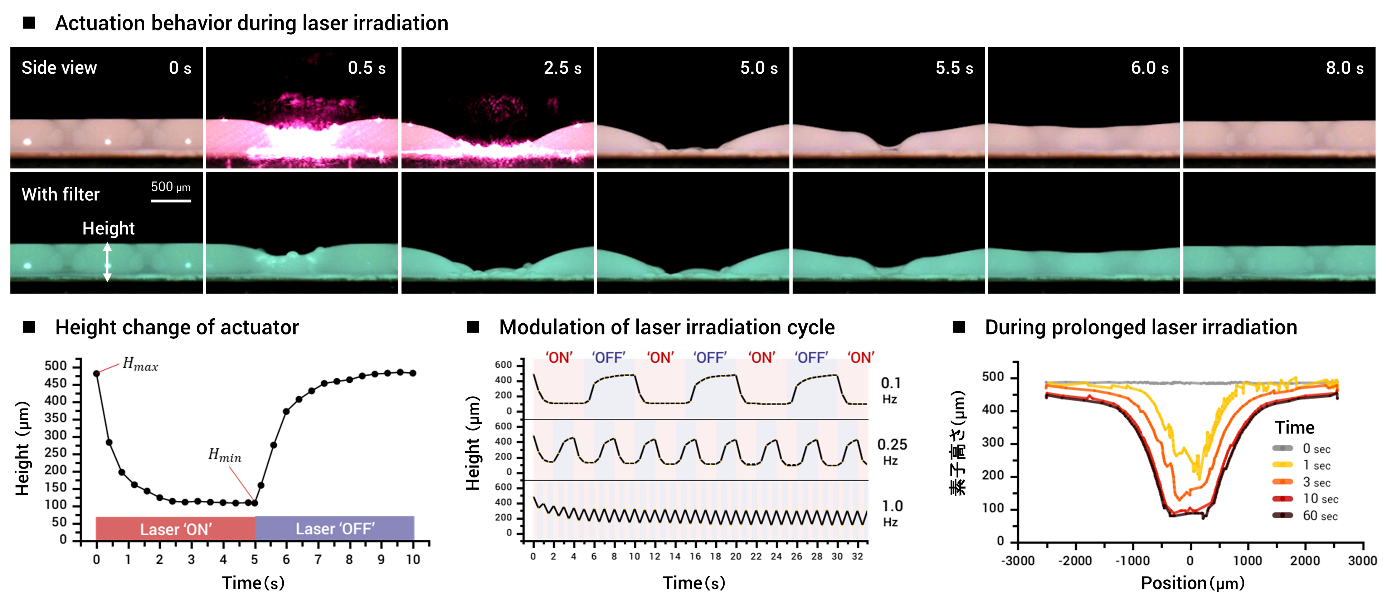Microsoft ends support for Internet Explorer on June 16, 2022.
We recommend using one of the browsers listed below.
- Microsoft Edge(Latest version)
- Mozilla Firefox(Latest version)
- Google Chrome(Latest version)
- Apple Safari(Latest version)
Please contact your browser provider for download and installation instructions.
March 29, 2023
Nippon Telegraph and Telephone Corporation
Light-driven on-chip actuator capable of mimicking the motion of biological organs
~contribution to the construction and validation of a bio-digital twin as an on-chip organ model~
Nippon Telegraph and Telephone Corporation (headquartered in Chiyoda-ku, Tokyo; Akira Shimada, President & CEO; hereinafter "NTT") has successfully fabricated an on-chip actuator that can reproduce the movement of an organ (*1). This was accomplished by using NTT's unique on-chip shape-morphing method (*3) to shape a hydrogel (*2) film, which moves quickly upon light stimulation, into a thin-film tube-like structure that mimic organs.
In this work, NTT has designed and fabricated a material capable of changing volume upon light stimulation by compositing a thin film of temperature-responsive poly-N-isopropylacrylamide gel (*4), which is also used as cell culture substrate, with gold nanorods (*5), which are photothermal conversion materials. Furthermore, by shaping this material into biomorphic shapes (thin-film and tubular shapes) using the on-chip shape-morphing method, segmental movement (*6) and peristaltic movement (*7) of an intestine by light stimulation have been realized with performance comparable to that of an organ. This achievement, which is a fundamental technology for reproducing an in vivo environment on a chip, is expected to lead to the construction and verification of a biodigital twin (*8) through the creation of on-chip artificial organs (*9) that can acquire a wide variety of data from various organs.
Details of this research were published in the American scientific journal Advanced Functional Materials on March 16, 2023 Eastern Time.
 Schematic illustration of the on-chip artificial organ
Schematic illustration of the on-chip artificial organ
1. Background
Technology to artificially reproduce advanced biological functions by culturing cells in vitro is important in a wide range of fields, including cell biology, regenerative medicine, and drug discovery. On-chip artificial organs that can reproduce biological functions on a sensor substrate are expected to provide a wide variety of information on various organs with cellular-level resolution as detailed data, leading to the construction of a biodigital twin modeled in a digital space based on the data. In addition, they may contribute as actual devices to verify the model compared to actual organs by inputting various parameters expected from the model. The challenge for the creating such an on-chip artificial organ is how to bring the cell culture environment closer to that of the living body, which requires technology that can simultaneously realize biologically friendly materials, shapes close to those in the living body, and an in vivo stimulation environment.
The research group has focused on hydrogel and studied technology for shape-morphing hydrogel into three-dimensional shapes. Hydrogel, a soft highly biocompatible material in which a large amount of water is retained in a polymer network, is widely used as a medical material (*10) and cell culture substrate because its properties are very similar to those of the tissues that make up our bodies. Using a unique on-chip shape-morphing method that leverages the physical phenomenon of buckle delamination and swelling of hydrogel film, we have succeeded in shaping hydrogel into thin-film tubular structures that mimic organs. If these shapes can be moved in a complex manner like an organ, they can be used as a platform to reproduce an in vivo-like dynamic stimulation environment and thereby advance the creation of on-chip artificial organs.
2. Achievements
In this study, we designed and fabricated a hydrogel film that can "be moved quickly by light" and applied the on-chip shape-morphing method to create a the light-driven actuator (Figure 1). Combining temperature-responsive poly-N-isopropylacrylamide gel, a material also used as a cell culture substrate, with gold nanorods, photothermal conversion materials, makes it possible to shrink only the light-stimulated area.
 Figure 1: Overview of light-driven on-chip actuator
Figure 1: Overview of light-driven on-chip actuator
By applying the on-chip shape-morphing method to this material, we have created thin-film tubular structures based on buckle delamination (*11). These structures closely resemble organs and can be moved smoothly and quickly by irradiating them with light, achieving world-class performance as a soft on-chip actuator capable of a high-speed response, large deformation, and a local response (Figure 2). Furthermore, by controlling the spatio-temporal characteristics of light stimulation, we succeeded in reproducing the segmental and peristaltic movements of the intestine with performance comparable to that of an organ. (Figure 3).
 Figure 2: On-chip actuators capable of high-speed response, large deformation, and local response
Figure 2: On-chip actuators capable of high-speed response, large deformation, and local response
 Figure 3: Demonstration of organ-like movements
Figure 3: Demonstration of organ-like movements
3. Technical features
The following are two key features of the technology used in this experiment to fabricate the high-performance on-chip actuator capable of mimicking the motion of an organ.
[1] Light-responsive material capable of rapid deformation
The poly-N-isopropylacrylamide gel, which serves as the base material, is made porous (*12) to enable rapid water entry and exit. In addition, by adjusting the content of gold nanorods, a photo-thermal conversion material, the design allows rapid heating to 35°C, the response temperature. This enabled us to fabricate a hydrogel material capable of high-speed shrinkage and deformation with heat generation by light irradiation.
[2] Buckling mechanism capable of large deformation
The buckle delamination for on-chip shape morphing can significantly deform thin film materials from a flat (two-dimensional) state to a buckled (three-dimensional) state. This buckling deformation mechanism enables displacement amplification that is one order of magnitude greater than normal swelling deformation, resulting in the world's top-level performance.
4. Outlook
This high-performance on-chip actuator is expected to serve as a basic technology for reproducing an in vivo-like environment on a chip and thereby contribute to the creation of on-chip artificial organs in combination with cell culture, which will be useful in cell biology, regenerative medicine, drug discovery, and other fields. In addition, the buckling deformation mechanism proposed in this study has potential applications in the field of soft robotics as a method of fabricating actuators that can be adapted to a wide range of thin-film materials. Furthermore, it is expected to be used in the field of microfluidics to dynamically control the shape of flow paths fabricated on a chip.
NTT will use the data obtained through this research to construct and verify a biodigital twin, aiming to help people live healthful and enriched lives.
5. Publication information
Journal: Advanced Functional Materials
Title: Biomorphic actuation driven via on-chip buckling of photoresponsive hydrogel films
Authors: Riku Takahashi, Aya Tanaka, and Masumi Yamaguchi
DOI: 10.1002/adfm.202300184
【Glossary】
1.Organ
Refers to a unit that constitutes the body of a multicellular organism. It is a collection of tissues that cooperate with each other to perform a certain function.
2.Hydrogel
A soft material which retains a large amount of water in networks of polymers. It exhibits properties intermediate between solids and liquids, and its characteristics include molecular permeability and volume change from swelling. Because of its high biocompatibility, it is widely used as a biomedical material for applications such as contact lenses, implantable materials in plastic and reconstructive surgery, and cell culture substrates.
3.On-chip shape-morphing method
NTT's unique method of controlling the adhesion between the hydrogel film and support substrate enables the fabrication of thin-film 3D architectures using swelling as the driving force.
https://www.brl.ntt.co.jp/J/2021/04/latest_topics_202104281845.html
4.Poly-N-isopropylacrylamide gel
A hydrogel that can contract in response to temperature while expelling retained water. It is biocompatible and used as a cell culture substrate.
5.Gold nanorod
A gold-derived nanomaterial with a capsule shape (like an elongated sphere). When irradiated with light of appropriate wavelength, it converts light energy into heat energy (photothermal conversion material). By adjusting the length of the rod, the light absorption peak can be controlled from 550 nm to about 1400 nm. This effect has been used in research on photothermal cancer therapy.
6.Segmental movement
One of the behaviors observed in the digestive tract, such as in the small intestine, and is a movement mainly responsible for fragmenting and agitating the intestinal contents.
7.Peristaltic movement
One of the behaviors observed in the digestive tract, such as in the small intestine, and is mainly responsible for the transport of intestinal contents.
8.Biodigital twin
Supporting the foundation of the NTT Medical and Health Vision, Bio Digital Twin (BDT) technology precisely maps each individual's body in cyberspace.
9.On-chip artificial organs
Also called a biofunctional chips; an organ-on-a-chip refers to a microfluidic device formed on a chip with the functions of a physiological organ. Using microfabrication technologies, a flow channel scaffold structure is created to culture organ cells and express organ functions. Organs-on-a-chip hold great promise as a technology for implementing clinical experiments without relying on lab animals or human subjects and is being actively researched with the aim of realizing various artificial organs.
10.Medical materials
Refers to materials used to make various devices, tools, and prostheses used in the medical and dental fields. Hydrogel is expected to be applied to artificial cartilage, artificial intervertebral discs, and artificial blood vessels.
11.Buckle delamination
A thin film is compressed from both ends to lift the bent central portion and deforms into an arch structure. This is called the buckling delamination phenomenon.
12.Porous
Refers to a structure with a very large number of open pores.
Media Contact
Nippon Telegraph and Telephone Corporation
Science and Core Technology Laboratory Group, Public Relations
nttrd-pr@ml.ntt.com
Information is current as of the date of issue of the individual press release.
Please be advised that information may be outdated after that point.
NTT STORY
WEB media that thinks about the future with NTT









